Digitaria bicornis
(Lam.) Roem. & Schult.
Hairy Finger Grass, Finger grass
An annual grass, erect or at first spreading along the ground before becoming erect, 20-115 cm tall, often rooting at the nodes (Fig. 1). Leaves cauline, arising at more or less regular intervals along the stem. Leaf-blades flat, 12-25 cm long, 3-12 mm wide. The basic flowering units or spikelets are arranged in 2-7 spike like branches, the branches either all arise from a central point (digitate) and terminate the flowering stem (Fig. 2) or are arranged with most branches digitate and additional branches arising from a common axis above or below the digitate whorl. The flowering heads are usually well exserted from the leaves. The spikelets (the basic flowering unit) are arranged in pairs along the ‘front’ side of the branch axis. These pairs alternate from one side of the branch axis to the other, leaving the winged branch clearly visible from the back (Fig. 3). The spikelet pairs consist of a lower spikelet, either stalkless or with a short stalk and an upper spikelet on a much longer stalk (Fig. 4). The spikelets consist of a very short lower glume and a longer upper glume which encloses two florets (modified grass flowers), a sterile lower floret and a fertile upper floret. The spikelets are dorsally compressed (flattened from front to back), so that they appear broadest from the front. In this species the spikelets in the pair are usually dissimilar in form, although this can be difficult to observe in some cases. Differences between the spikelets are reported below under botanical description and diagnostic features.
Botanical Description
An annual, decumbent or erect, 20-115 cm high (Fig. 1). The leaves cauline, with leaf blades linear, flat, 12-25 cm long, 3-12 mm wide; hairy. The leaf sheaths hairy or glabrous. The inflorescence subdigitate, with 2-7 racemose branches, the common axis of the inflorescence 0-2.5 cm long (Fig. 2). The branch of each raceme winged and one-sided, up to 16 cm long. The spikelets are paired, the lower spikelet on a short stalk or sessile, the upper spikelet stalked; spikelets dissimilar (heteromorphic) in shape, arrangement of nerves and hairiness (Fig. 5 & 6). Spikelets are 2.9-3.6 mm long; the lower glume is short, to 0.3 mm long, the upper glume 2.8-3 mm long. The lower lemma of the pedicelled or stalked upper spikelet has 7 nerves, 5 prominent, with the space between them inequidistant, i.e. the space between the middle nerve and the first nerve on either side of it are wider than the spaces between the first set of lateral nerves and the 2nd set of lateral nerves (Fig. 6a). The upper spikelet has a mix of sericeous (silky) hairs and bristles, both spreading and distinct at maturity (Fig. 5a). The lower lemma of the stalkless or lower spikelet has 7 nerves, 5 prominent, with the space between them equidistant, i.e. all nerves with more or less the same space between them (Fig. 6b).
Diagnostic Features
Digitaria bicornis can be identified by the annual habit and large inflorescence, with several branches arising from a central point and occasionally also with an extended central axis (Fig. 2). If unfamiliar with Cynodon or Alloteropsis it may be confused with species of those genera, however, they are easy to differentiate. Cynodon has solitary spikelets arranged along the branch and Alloteropsis has much bigger spikelets which are awned. Distinguishing Digitaria bicornis from other species of Digitaria such as Digitaria ciliaris and Digitaria setigera can be much more challenging and almost impossible without access to magnification tools. Following work done by Boonsuk et al. (2016) the characters considered useful for distinguishing between these three species relate to the similarities and differences between the lower and upper spikelet in a spikelet pair, and the size and presence of the lower and upper glumes. Even with magnification and access to known specimens for comparison, distinguishing between specimens takes both time to understand the characters properly and careful observation. For those motivated to take the time, a summary of the diagnostic characters is provided below.
In Digitaria bicornis the lower and upper spikelets are different (hetermorphic), the nerves of the lower lemma in the lower spikelet are equidistant, that is the spaces between all nerves are more or less equal, while the nerves of the lower lemma in the upper spikelet are inequidistant or unequal (Fig. 6a & b ). Nerve spacing can be sometimes difficult to see depending on the maturity of the seed, which may affect the shape of the lemma, or the degree and type of hairiness between the first and second lateral nerves. Care must be taken here to ensure the spikelets in the same pair are being compared. The lower spikelet can be underdeveloped towards the base of the branch, or the lower or upper spikelet may have fallen off in more mature specimens. Also the upper spikelet has long spreading white hairs and bristles (Fig. 5a), sometimes these are not always obvious either because the hairs and bristles are held appressed against the lemma or the upper spikelets have fallen off. Try to observe spikelets along the length of the branches and more than one inflorescence as at least one or two spikelets with the classic spreading hairs and bristles are usually present. In contrast, both spikelets of Digitaria ciliaris are similarly hairy (homomorphic), with appressed hairs on the margin of the spikelet and often between the outer nerves of the lower lemma. The hairs are rarely spreading (i.e. held at right angles to the lemma) like D. bicornis, but if so, the hairs are shorter than those found in D. bicornis, and the spikelets lack the long bristles of D. bicornis. The nerves on both spikelets will be inequidistant.
Digitaria setigera is distinguished form D. bicornis by the absence of the lower glume and the much smaller upper glume < 1 mm long in D. setigera and > 1mm in D. bicornis. For further information on D. setigera and D. ciliaris see the factsheets for these species also provided in this series.
In sub-tropical and temperate Australia Digitaria bicornis is very similar to Digitaria sanguinalis distinguished mainly by the hetermorphic spikelets.
Natural Values
Digitaria bicornis is a pantropical species currently recognised as native in Queensland (Jessup 2017).
Habitat
In tropical and subtropical sub-humid woodlands, vine forest, shrublands, and coastal grasslands. A species preferring coarse-textured soils in tropical or subtropical areas. It is widely collected from Cape York Peninsula (Fig. 8).
Land Management Notes
This species may be misidentified in the field as Digitaria ciliaris.
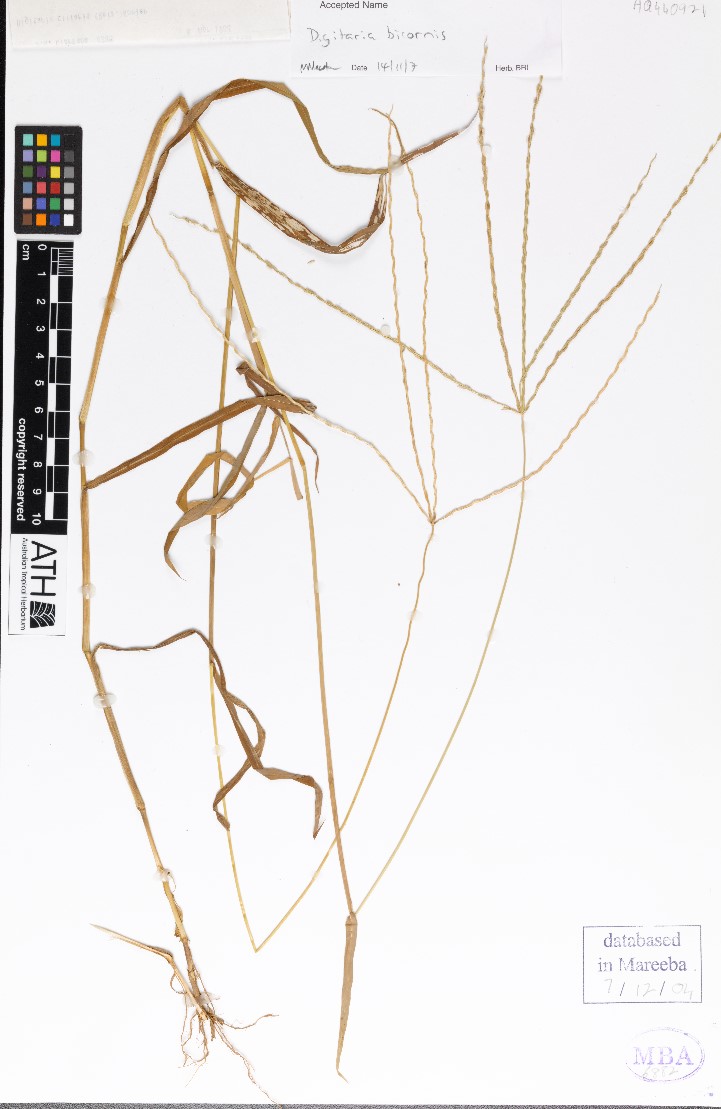
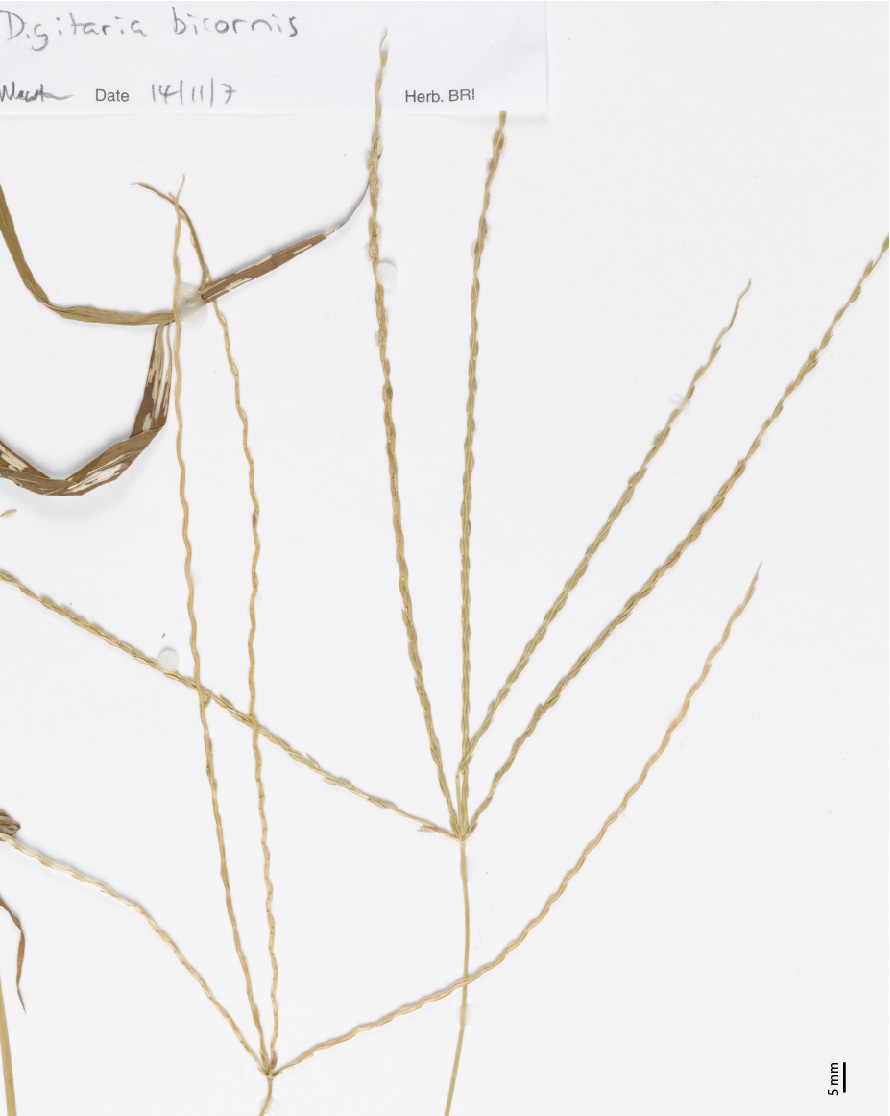
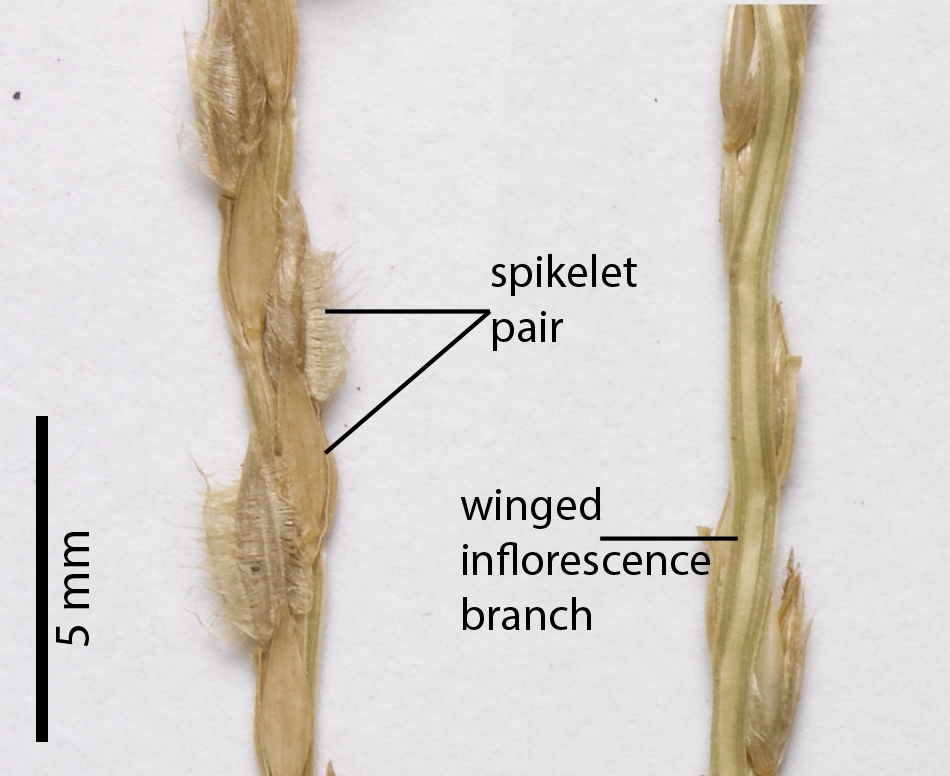
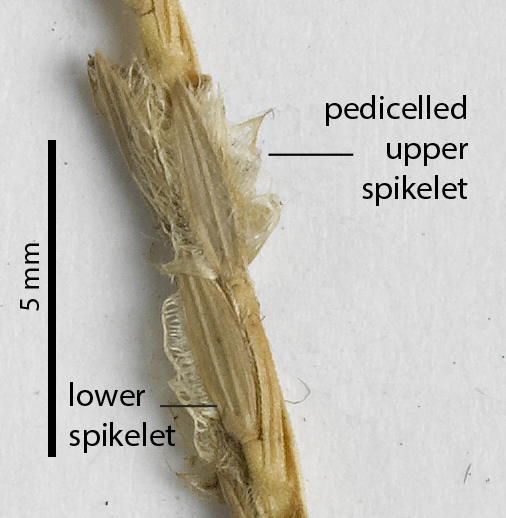
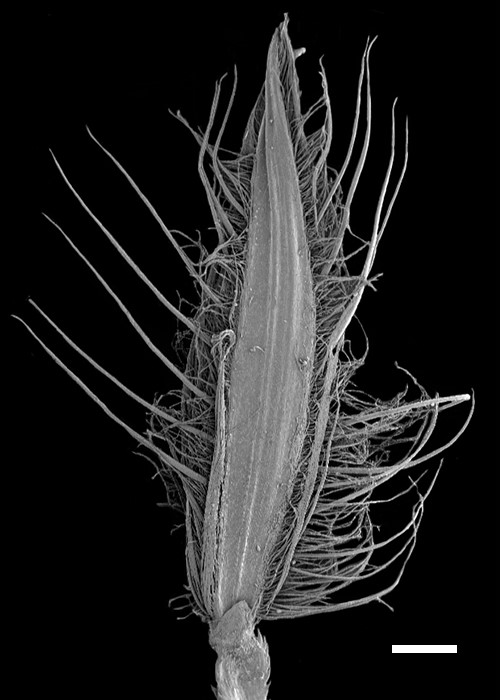
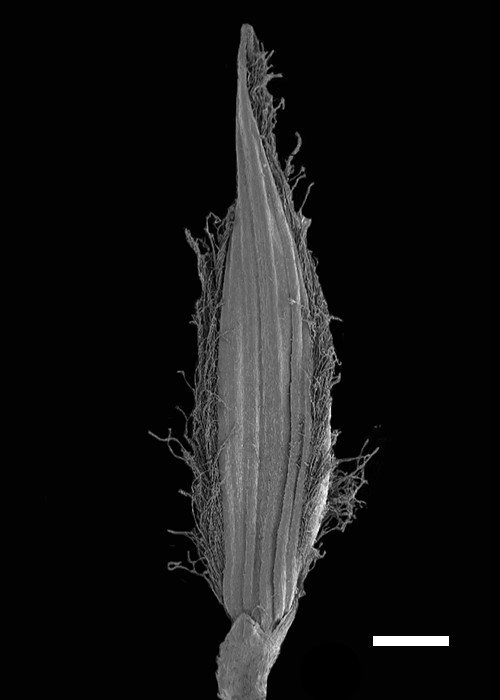
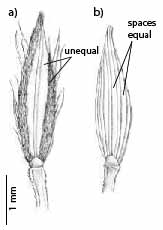

Resources
AVH (2017) Australia’s Virtual Herbarium, Council of Heads of Australasian Herbaria, <http://avh.chah.org.au>, accessed 30 May 2017.
Boonsuk, B., Chantaranothai, P. & Hodkinson, T.R. (2016), A taxonomic revision of the genus Digitaria (Panicoideae: Poaceae) in mainland Southeast Asia. Phytotaxa 246(4): 266
Clayton, W.D., Vorontsova, M.S., Harman, K.T. and Williamson, H. (2006 onwards). GrassBase - The Online World Grass Flora. http://www.kew.org/data/grasses-db.html. [accessed 21 March 2018].
Jessup, L.W. (2017). Digitaria. In P.D.Bostock & A.E.Holland (eds), Census of the Queensland Flora 2017. Queensland Department of Science, Information Technology and Innovation: Brisbane. https://data.qld.gov.au/dataset/census-of-the-queensland-flora-2017, accessed 26 March 2018.
Simon, B.K. & Alfonso, Y. (2011) AusGrass2, http://ausgrass2.myspecies.info/accessed on [date 29 March 2017].
Vega, A. & Agrasar, Z. (2006). Digitaria. In A. M. Molina & Z. E. Rúgolo de Agrasar (eds). Flora Chaqueña (Formosa, Chaco y Santiago del Estero), vol. 23: pp.454-492.

